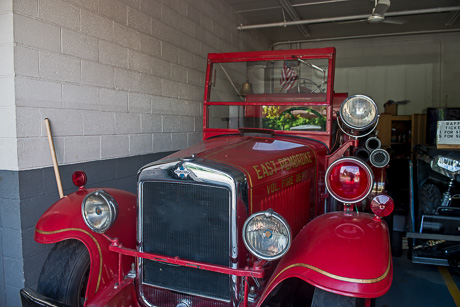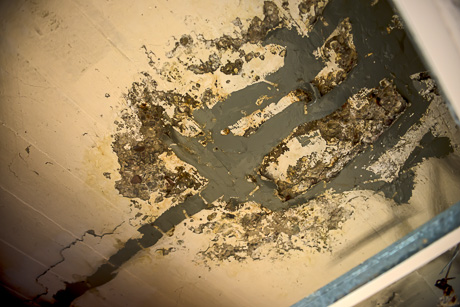The fire hall in East Pembroke has served its department well for more than 80 years. Now, Fire District officials hope the department's next fire hall will serve the community well for another 80 to 100 years.
If there is a new fire hall.
Voters will need to approve the expenditure and tax increase to make it possible, and Fire District Commissioner Bill Lawrence says it's absolutely essential to approve the expenditure if East Pembroke Fire is going to continue to provide essential service to the 100 square miles and 5,500 residents over its coverage area.
The proposed fire hall would sit on land purchased by the district more than a decade ago that is a little bit east of the current location. The building would be 11,128 square feet and cost $3 million.
It would contain not only more room for existing fire trucks, but rooms for hose drying, decontamination and air packs.
"It's by no means a castle," Lawrence said. "It's just a basic building. It's got what we need and stuff that we should have had."
For a district that has traditionally held the line on tax increases, the proposal might make some property owners gulp. The tax assessment would go up from the current $1.10 per $1,000 of assessed value to $1.98.
But that price factors in future inflation, new trucks, ongoing maintenance and other expenses.
"There won't be another tax rate increase for 20 years," Lawrence said.
The district, Lawrence said, has always tried to keep taxes down, even while always paying cash for new trucks and keeping its annual budget at $150,000 or less.
Now the district faces a situation where the fire hall must be replaced, but there's not enough money in the bank to cover all of the costs.
"Our feeling was to let the people keep their money," Lawrence said. "We've been asked, 'why didn't you increase the tax rate right along?' But we felt it was better to let people keep their money."
There will be a public meeting June 18 at St. Mary's to discuss the new fire hall and make the case that the expenditure is critically necessary.
A visit to the fire hall's basement might be the district's most convincing evidence.
The former rec hall for the department sits under three bays that were built in the 1970s. The floor was designed to support only 14,000 pounds. The current trucks occupying those three bays weigh more than 45,000 pounds.
On the advice of an engineer, the rec hall was gutted and support beams were constructed.
The lowest available price from a contractor for the support construction was $30,000. The department was able to reduce the sum with its volunteers and material donated by Ed Arnold Scrap, Jay E. Potter Lumber and Fastenal (top photo).
The 1930s era portion of the structure was designed to support on 8,000 pounds and it currently contains a 12,000-pound rescue truck.
The structural problems with the building came to light after a car struck the fire hall Nov. 15, 2012. Before the accident, replacing the fire hall was on the district's long-term to-do list, but didn't become a matter of urgency until the accident brought code inspectors and engineers to the property who found the structure was insufficient for its current use.
Firefighting has changed a lot since the 1930s. Trucks have gotten bigger and the state has implemented ever more stringent and costly regulations.
For example, new turnout gear for interior firefighters must be purchased every 10 years, at a cost of $3,500. New air packs must be purchased every 15 years and cost $6,500 each. The state requires all tires on fire trucks be replaced every 10 years, whether the tires are worn or not.
Recently, more and more residents have been putting steel roofs on their homes and barns. That presents a new firefighting challenge because the roofs are harder to access -- especially in frosty or wet whether -- to ventilate a fire (a key firefighting strategy).
The increase in steel roofs means the district needs to buy a new ladder truck at a cost of $675,000.
"Somebody might ask, why are you going to get ladder truck and it's for that reason," Lawrence said. "We can't take care of these houses and some the barns that are getting these roofs on them. We're being pushed into a lot of stuff where we don't have control. It's depressing because you're losing control and still they're coming out with more regulations."
Lawrence also feels like the companies that supply fire departments with apparatus have the departments in a monopolistic hammerlock, giving them the ability to inflate prices.
Rescue 57 cost $270,000, a price Lawrence said is outrageous.
"It's like a wedding," Lawrence said. "If you're going to go anywhere for a wedding, and they know it's a wedding cake, they know it's a wedding dress, they know it's anything else, it doubles the price. They know it's related to fire, they kick the price up. There's no reason that truck should have cost nearly $300,000. No reason at all."
The current fire hall is owned by the East Pembroke Fire Department and Lawrence said district officials feel it would be better for the district to own the fire hall. Building a new one will give the district the chance to correct that historic anomaly.
The fire department would then sell the current hall -- which, if you need to know -- is not the same parcel as the mud race pits, so the annual mud races would be unaffected by the sale.
The department goes out on nearly 300 calls a year and currently has 31 volunteer firefighters. The district projects growth in the area that will mean 400 calls annually by 2034 and the department will need 55 volunteers to operate.
There simply isn't room in the current building to upgrade it enough to accomodate that growth. But even just upgrading the electrical, the structural, the mechanical and making it handicapped accessible (which would be required under federal law) would cost nearly $1 million.
Voters in the Town of Barre recently turned down a new fire hall proposal that was about half the price East Pembroke is seeking, but Lawrence said that vote doesn't concern him much.
"It doesn't make us nervous because we know what we have to have to serve the residents of the district," Lawrence said.
This fire truck arrived at EPFD new in 1934. It's the kind of truck the 1930s era fire hall was built to hold; not the massive engines of today. This truck is still technically operational, but is used for display and parades.
The crumbling cement of the floor of the firehouse as seen from the basement.
File photo from the 2012 accident that made the defects with the current fire hall much more obvious.



